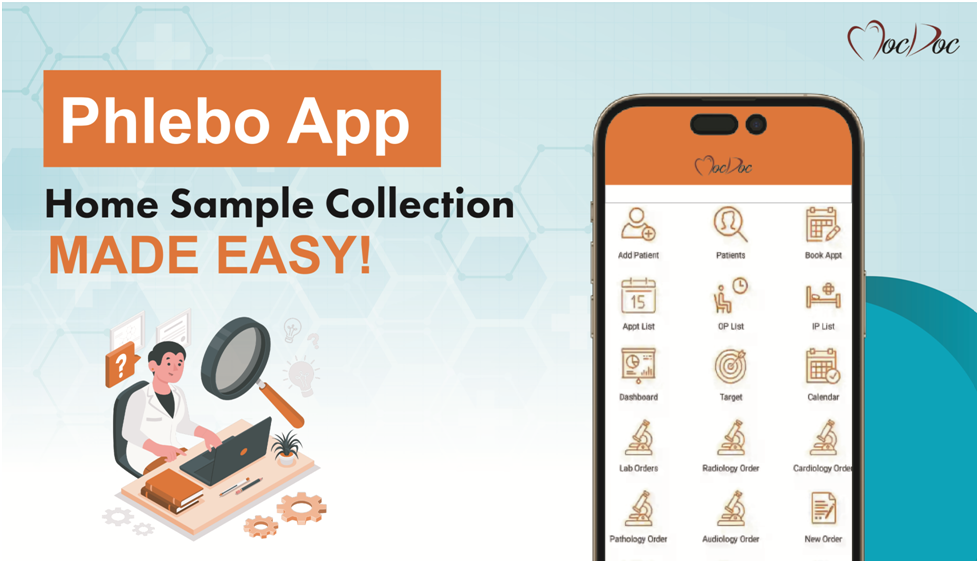MocDoc's Offerings
Eliminating Inconveniences at Home Sample Collection: The Phlebo App
Published By
Preethi
2023072814:29:21
Category LIMS

The need for home collection of samples has become increasingly important, providing convenience for patients who are unable to visit a medical facility. However, several challenges are faced in this process. Coordinating the arrival of phlebotomists and patients can be a logistical hurdle. Accurate documentation, including recording collection time, managing payments, and capturing prescriptions, is crucial but can be prone to errors. Ensuring the safe and timely movement of samples from patients' homes to the laboratory while maintaining sample integrity adds complexity. Overcoming these challenges is essential to providing efficient and reliable home sample collection services.
The MocDoc’s Phlebo mobile/web application is designed to streamline the process of home collection for test samples, ensuring efficient tracking and management. This application is utilized by the phlebotomist responsible for collecting test samples from patients' homes and facilitating their movement to the laboratories for testing. The Phlebo application plays a crucial role in maintaining the integrity and traceability of the samples throughout the entire process of home collection and subsequent testing, providing a reliable solution for healthcare professionals, and ensuring accurate diagnostic outcomes. This application is used in the pre-analytical phase of the sample lifecycle.
Home Collection Workflow
Upon receiving an order for home collection, the laboratory ensures that a skilled phlebotomist is assigned to carry out the sample collection. To ensure smooth coordination, the phlebotomist notifies the patient in advance regarding their arrival time for the collection process.
Using a mobile app, the phlebotomist records the precise time of collection. Following the successful collection, the phlebotomist proceeds to collect the payment from the patient. To keep the records up-to-date, the phlebotomist updates the payment status within the mobile app. Additionally, an image of the prescription is uploaded as part of the documentation process.
After securing the payment and recording all necessary information, the phlebotomist carefully collects the required sample from the patient. To maintain sample integrity and proper identification, the phlebotomist associates the sample with a specific barcode linked to the requested test. This barcode ensures accurate tracking and traceability of the sample throughout its journey to the laboratory.
The phlebotomist then takes responsibility for the safe and timely movement of the collected samples from the patient's location to the laboratory. Ensuring proper handling and adherence to transportation protocols, the phlebotomist guarantees that the samples reach the laboratory in a secure and reliable manner.
Upon completion of all assigned home collections, the phlebotomist generates batch sheets summarizing the collected samples and relevant details. These batch sheets, along with the collected samples, are submitted to the laboratory for further processing. The laboratory meticulously validates and accepts the samples, preparing them for analysis and subsequent testing procedures.
Benefits of using the Phlebo app to handle sample movement for home collection
The fundamental concept of home collection service aims to facilitate customers by enabling them to have their samples collected from their location, thereby alleviating the burden of visiting the laboratory for diagnostic testing. This service proves valuable, particularly for individuals who face challenges in terms of accessibility, bedridden patients, or circumstances like fasting sample collection.
This mobile application offers significant benefits to phlebotomists as it allows them to record essential aspects of sample movement such as time, location and patient prescription, all from a single interface. This feature eliminates the need for manual processes and reduces the potential for manual errors.
There are several advantages associated with utilizing the Phlebo app
- Precise tracking and tracing of sample collection and movement leave no room for doubt regarding the validity of the collected sample. Consequently, any potential delays can be readily anticipated and mitigated, thereby avoiding manual errors that could negatively impact the test results.
- Efficient quick billing and payment collection processes facilitated by the app, ensuring that accounts remain accurate and up-to-date with no outstanding dues.
- Streamlined initiation of new test orders, which can be achieved with ease through the app’s user-friendly interface.
With a comprehensive tool, it is easy to facilitate seamless sample collection and movement for the home collection process. Ensure accuracy, traceability, and efficient communication, and experience the convenience and reliability of our advanced solution. Contact us and elevate your home collection process with MocDoc's Phlebo app.
Related Articles
Why Many laboratories Fail And...
Going wrong in experiments taking place in laborat..... Read more
Using LIMS for Quality Control...
Keeping up with the fast-evolving world of trends ..... Read more
What are the criteria to choos...
Laboratory Information Management System (LIMS) is..... Read more



